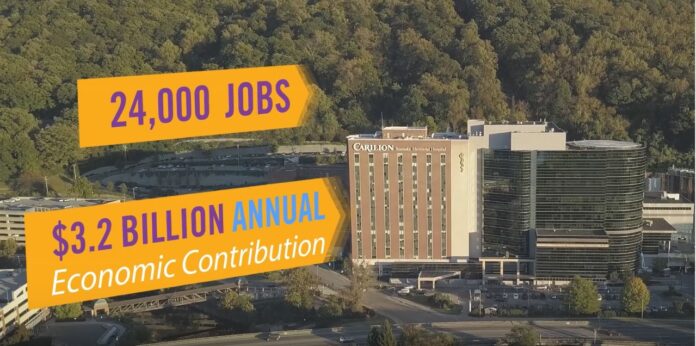Carilion Clinic generated more than $3.2 billion and nearly 24,000 jobs for Virginia’s economy in 2018, according to an economic impact study released today by Carilion and The University of Virginia’s Weldon Cooper Center for Public Service’s Center for Economic and Policy Studies.
“Carilion plays a vital role in the health and well-being of the communities we serve as well as the state’s economic health,” said Nancy Howell Agee, president and CEO of Carilion. “This study provides a snapshot of our operations, and it’s encouraging to see the ripple effect that extends far beyond our walls.”
The Weldon Cooper Center for Public Service provides policy analysis, economic forecasting, regional studies, and other services. This study, the first commissioned by Carilion, analyzed data from Oct. 1, 2017, through Sept. 30, 2018, Carilion’s fiscal year, including spending and employment growth of the Carilion Clinic system independent of its partnerships with Virginia Tech and Radford University.
Findings point to continued growth of Carilion’s employee base, payroll, and investments in local business. There is also a ripple effect as a growing number of employees and their families purchase goods and services. Taking these factors into consideration, the study finds that for every ten Carilion jobs, another eight jobs are created in the Commonwealth.
“Looking back over the last decade or more, it’s not surprising to see these numbers,” said Steve Arner, Carilion’s executive vice president and chief operating officer. “As the largest private employer west of Richmond and a provider of care to more than a million people, our responsibility to the community drives our decisions and resulting growth.”
In fiscal year 2018, Carilion employed 13,317. The health system contracted with an additional 4,106 Virginians as vendors. Employee household spending supported another 6,296 jobs throughout the Commonwealth, according to the report.
The report also found that spending by Carilion and its employee households benefited local business sectors, such as retail, education and manufacturing. For example, the ripple effect from Carilion spending in fiscal 2018 generated:
- Nearly $2.7 million in the local service industry, which includes spending on health care, education, entertainment and real estate.
- More than $155 million in trade revenue, which includes retail and wholesale business.
- More than $126 million in the transportation, information and public utilities (TIPU) industries.
Community leaders, including Beth Doughty, executive director of the Roanoke Regional Partnership, the region’s economic development marketing arm, view Carilion’s success as an asset, boosting the region’s reputation as a desirable business location.
“As Carilion grows, so does the demand for other services in our region,” said Doughty. “We continue to attract businesses as a result, which stimulates further growth in our local economy. It’s a case where a rising tide lifts all ships, which makes the findings of this study so important.”
This study comes on the heels of several major announcements by Carilion, including plans to invest $1 billion system-wide over the next seven years. Projects include an expansion of its tertiary/quaternary care center, Carilion Roanoke Memorial Hospital, and the creation of a Carilion Children’s pediatric care facility at Tanglewood Mall. Though these capital improvements were not factored into this study, they will help Carilion meet current and anticipated needs, ultimately leading to additional jobs and spending in the region.
And, while Carilion is set to spend $1 billion on bricks and mortar, the system will invest more than $6 billion in staff through payroll alone over the same time period. The average Carilion employee (excluding physicians) makes $56,000 per year. Employee salaries go a lot farther here than in the majority of the country’s metropolitan areas, thanks to the region’s low cost of living – ten percent below the national average and more than 60 percent lower than that of Northern Virginia.*
“It’s certainly an exciting time to be in our region,” said Agee. “Thanks to the passion and commitment of our teams, support of our community and strong partners, our transformation and growth over the past decade has contributed to our region’s rise. Looking ahead to the next ten years, the future is just as bright.”
Read the full report by clicking here.


